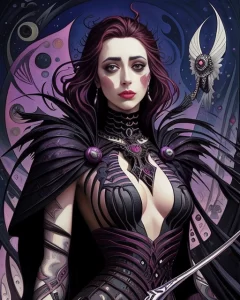The world of Non-Fungible Tokens (NFTs) is a rapidly evolving landscape, bursting with potential and diverse projects. But for the curious newcomer, one question often arises: Which blockchain is the right fit for my NFT adventure?
Unlike their fungible counterparts like Bitcoin or Ethereum, NFTs require specific technical foundations to exist and thrive. These foundations come in the form of blockchains, decentralized ledgers that provide the security, transparency, and immutability essential for NFTs. But with numerous blockchains vying for attention, choosing the right one can feel like navigating a digital jungle.
Fear not, intrepid explorer! This comprehensive guide will illuminate the diverse paths through the NFT blockchain ecosystem, empowering you to make informed decisions based on your needs and goals.
The Undisputed King: Ethereum and the ERC-721 Standard
Reigning supreme in the NFT realm is Ethereum, the blockchain that ignited the NFT revolution. Its ERC-721 token standard provides the backbone for most NFTs, offering robust functionality and widespread adoption. From the iconic CryptoPunks to the groundbreaking Bored Ape Yacht Club, countless NFT projects call Ethereum home.
The Perks of Ethereum:
- Unmatched Security: Ethereum benefits from a vast, established network, securing your NFTs with robust cryptography.
- Decentralization Powerhouse: Its decentralized nature ensures censorship resistance and transparency, crucial for NFT ownership.
- Vibrant Community: Ethereum boasts a thriving developer and user community, fostering innovation and support.
- DApp Integration: The Ethereum Virtual Machine (EVM) enables seamless integration with decentralized applications (dApps), expanding NFT utility.
The Thorns in the Ethereum Rose:
- Scalability Woes: Ethereum’s popularity creates network congestion, leading to high transaction fees and slow processing times.
- Environmental Concerns: Its Proof-of-Work (PoW) consensus mechanism raises concerns about its environmental impact.
Beyond the Ethereum Horizon: Alternative Blockchain Ecosystems
While Ethereum remains a dominant force, alternative blockchains are emerging, each offering unique advantages and considerations:
1. Solana: Speed Demon with Scalability:
- Blazing Fast: Solana boasts impressive transaction speeds, enabling near-instantaneous NFT minting and trading.
- Scalable by Design: Its innovative Proof-of-History consensus mechanism promises to handle high transaction volumes efficiently.
- Lower Fees: Compared to Ethereum, Solana offers significantly lower transaction fees, making it attractive for cost-conscious users.
However, keep in mind:
- Maturing Ecosystem: Solana’s NFT ecosystem is still evolving, with fewer established projects compared to Ethereum.
- Technical Complexity: Its unique architecture might require additional technical expertise for developers.
2. Polygon: The Ethereum Sidekick:
- Ethereum Sidechain: Polygon operates as a sidechain to Ethereum, inheriting its security while offering faster and cheaper transactions.
- EVM Compatibility: Its compatibility with the Ethereum Virtual Machine (EVM) allows existing Ethereum tools and dApps to easily migrate.
- Growing Popularity: Polygon has gained significant traction, attracting various NFT projects and marketplaces.
But remember:
- Centralized Aspects: Some aspects of Polygon’s infrastructure are centralized, raising concerns for purists who value absolute decentralization.
- Limited Functionality: Compared to Ethereum, Polygon’s smart contract functionality might be less mature for complex use cases.
3. Flow: Designed for NFTs:
- Tailored for NFTs: Flow is specifically designed for NFTs, offering optimized features for minting, trading, and managing digital assets.
- Fast and Secure: Its unique architecture ensures high transaction speeds and robust security.
- Growing Market: Flow’s NFT ecosystem is steadily expanding, attracting established brands and creators.
Yet, be aware of:
- Limited Adoption: Compared to Ethereum and Solana, Flow’s user base and developer community are still relatively smaller.
- Emerging Ecosystem: As a newer platform, Flow’s NFT ecosystem is still finding its footing, with fewer established projects and tools.
4. Cardano: Eco-Conscious Contender:
- Sustainable Choice: Cardano utilizes a Proof-of-Stake (PoS) consensus mechanism, leading to significantly lower energy consumption compared to PoW blockchains.
- Security-Focused: Cardano prioritizes security, building its infrastructure on a rigorous research foundation.
- Active Development: Cardano’s development team is constantly improving its platform, with NFT capabilities evolving rapidly.
However, consider these points:
- Evolving Ecosystem: Cardano’s NFT ecosystem is still nascent, with fewer established projects and functionalities compared to other options.
- Technical Learning Curve: Developers might need to adapt to Cardano’s unique programming language and development environment.
Table of Contents:
Choosing Your Path: Factors to Consider (Continued)
Selecting the right blockchain for your NFT journey hinges on understanding your specific needs and priorities. Here are key factors to ponder:
1. Project Type:
- Collectibles and Artwork: Consider established blockchains like Ethereum or Solana for wide audience reach and established marketplaces.
- Gaming NFTs: Look for blockchains with high throughput and scalability like Solana or Flow for seamless in-game experiences.
- Music and Ticketing: Blockchains with lower fees and fast transactions like Polygon or Flow might be suitable for micro-transactions and event ticketing.
2. Technical Expertise:
- Beginner-Friendly: If you’re new to the space, Ethereum or Polygon offer established tools and communities for support.
- Developing dApps: Choose a blockchain with EVM compatibility like Polygon or Avalanche for easier integration with existing tools.
- Custom Functionality: Blockchains like Flow or Cardano might be attractive for developers seeking unique features and control over their projects.
3. Environmental Impact:
- Sustainability Seekers: Opt for blockchains like Cardano or Tezos utilizing energy-efficient PoS consensus mechanisms.
- Transparency and Trust: Investigate the governance and decision-making processes of each blockchain to align with your values.
4. Fees and Scalability:
- Cost-Conscious Creators: Explore blockchains like Solana, Polygon, or Avalanche for lower transaction fees.
- High-Volume Projects: Prioritize blockchains like Solana or Flow for their ability to handle high transaction volumes efficiently.
5. Community and Ecosystem:
- Established Presence: Leverage the vast community and resources of Ethereum for wider reach and easier adoption.
- Emerging Innovation: Explore newer ecosystems like Flow or Cardano for their potential for cutting-edge features and early adopter benefits.
Beyond the Binary: Exploring Interoperability
The NFT landscape is not a zero-sum game. As the technology matures, interoperability solutions are emerging, enabling NFTs to move between different blockchains seamlessly. This opens exciting possibilities for wider reach, increased liquidity, and innovative cross-chain experiences.
The Future Unfolds: A Dynamic Ecosystem
The world of NFT-compatible blockchains is constantly evolving. This guide provides a snapshot of the present, but remember, the future is dynamic. Staying informed about emerging trends, exploring new developments, and actively engaging with the community will empower you to navigate the ever-changing NFT landscape with confidence.
Additional Resources:
- OpenSea: https://opensea.io/
- Ethereum: https://ethereum.org/
- Solana: https://solana.com/
- Polygon: https://polygon.technology/
- Flow: https://flow.com/
- Cardano: https://cardano.org/
- Tezos: https://tezos.com/







